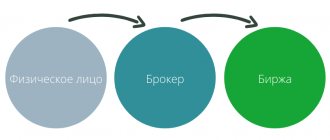What are dividends
A certain company wants to attract outside capital to produce an innovative product. The management does not want to take out a loan: loans will worsen the economic condition of the company.
The best option is to issue shares, promising their buyers regular payments depending on the company's future net profit.
Such payments are called dividends. Dividends can be paid every month, once a quarter, 2 times a year (after each half-year) or 1 time a year - it all depends on the company’s Charter.
In simple words, this is passive income that does not require close attention or participation in any activity.
There is a relationship between the stock price and the amount of dividends on it. In the stock market they use the term “dividend yield”. The size of payments is not usually considered in absolute terms (5 kopecks, 63 rubles, 300 dollars, etc.), preferring to express it relative to the market price of the share.
For example, a dividend yield of 12% means that for every thousand invested in securities, over the year you will receive 120 rubles from the issuer (the company that issued these securities to develop its economic activities).
Using relative values, it is convenient to compare stocks with each other, choosing the best options.
The absolute value is for reference only and is indicated in economic reports, but traders are accustomed to using dividend yield.
How much can you earn from them?
Since the size of dividends is defined as a relative value, you can easily calculate how much you will be able to earn.
On the Internet you can find data on dividend yields of all domestic companies traded on the Moscow Exchange.
In particular, analysts at dohod.ru predict that the spread in payments at the end of 2021 will range from 4 to 17%.
For example, Alrosa-Nyurba shareholders will receive 15.3% for the year, and holders of Sberbank preferred securities - 10.67%.
This is 1.5–2 times higher than the interest rate on a deposit in any bank!
In rare cases, it happens that the dividend yield is higher than 15–20%. These are one-time payments that bear a significant burden on the economic activity of the issuer. The finances that the company could have spent on development and modernization essentially go to strangers.
Is it possible to live on them?
To receive 40,000 rubles a month (and somehow more or less live alone on this amount), you need to invest 3 million 200 thousand rubles. in securities with an annual dividend yield of 15%. For smaller payouts, the investment amount should be proportionately larger.
But the annual payment of dividends is not guaranteed; everything depends on the economic activity of the company and the decision of the general meeting of shareholders.
Dividends from past losses
In the company's balance sheet for 2021, under the item “Retained earnings (uncovered loss),” there is an uncovered loss, and according to the financial results report for 2021, a net profit was received. At the same time, the data on the balance sheet item “Additional capital (without revaluation)”, formed from contributions to the company’s property, provide generally positive net assets. Can the company distribute dividends for 2021?
First of all, it should be borne in mind that this issue is regulated exclusively by civil and corporate legislation, and accounting here only reflects the facts of economic life, the rules of occurrence, existence and termination of which are established by the specified legislation.
And this approach, it is important to note, is not a deviation from the requirement to reflect the facts of economic life, based on the priority of their economic content over the legal form (clause 6 of the Accounting Regulations “Accounting Policy of the Organization” (PBU 1/2008), approved by Order of the Ministry of Finance of Russia dated 06.10.2008 No. 106n, hereinafter referred to as PBU 1/2008). Therefore, in this case, IFRS standards cannot be applied, which should be addressed in the absence of methods for accounting for specific facts of economic life in Russian accounting (clause 7.1 of PBU 1/2008).
According to paragraph 1 of Art. 28 of the Federal Law of 02/08/1998 No. 14-FZ “On Limited Liability Companies” (hereinafter referred to as Law No. 14-FZ), the company has the right to make a decision quarterly, once every six months or once a year on the distribution of its net profit among the participants of the company. The decision to determine the part of the company's profit distributed among the company's participants is made by the general meeting of the company's participants.
At the same time, according to paragraph 1 of Art. 29 of Law No. 14-FZ, a company does not have the right to make a decision on the distribution of its profits among the participants of the company:
- until full payment of the entire authorized capital of the company;
- before payment of the actual value of a share or part of a share of a company participant in cases provided for by this federal law;
- if at the time of making such a decision the company meets the criteria for insolvency (bankruptcy) in accordance with the federal law on insolvency (bankruptcy) or if the specified signs appear in the company as a result of such a decision;
- if at the time such a decision is made, the value of the company’s net assets is less than its authorized capital and reserve fund or becomes less than their size as a result of such a decision;
- in other cases provided for by federal laws.
In general, similar restrictions on the payment of dividends are contained in paragraph 1 of Art. 43 of Federal Law No. 208-FZ of December 26, 1995 (hereinafter referred to as Law No. 208-FZ).
In accounting, net profit is reflected in account 99 “Profits and losses”, in financial statements - in the article “Net profit (loss)” of the income statement. At the same time, the balance sheet under the item “Retained earnings (uncovered loss)” reflects an object of a different kind than net profit. This is noted in the Letter of the Ministry of Finance of Russia dated August 23, 2002 No. 04-02-06/3/60: “the indicators “net profit” and “retained earnings” are formed on different accounting accounts and have different meanings.”
To avoid any contradictions between the norms of corporate legislation on the distribution of net profit as dividends and the possibility of their payment from retained earnings of previous years (including in the event of a loss on the financial results statement for the reporting year), it is considered that retained earnings in the balance sheet are as it were, also net profit in the form of the sum of net profits for individual years.
Thus, the cited Letter of the Ministry of Finance of Russia dated August 23, 2002 No. 04-02-06/3/60 states that net profit is formed on the organization’s balance sheet only at the end of the current (reporting) year. In the Letter of the Federal Tax Service of Russia dated October 5, 2011 No. ED-4-3/ [email protected], after the phrase that in order to recognize payments in favor of an organization as dividends, it is necessary that the payments be made at the expense of the organization’s net profit, it is said that neither tax nor civil legislation does not contain restrictions on the payment of dividends in the current year from retained earnings of previous years in the absence of funds.
Moreover, such an interpretation is allowed by corporate legislation itself. So, in paragraph 2 of Art. 42 of Law No. 208-FZ states that the company’s net profit is determined according to the company’s accounting (financial) statements. Without specifying which of its forms - the income statement or the balance sheet. There is no such indication in Law No. 14-FZ, but we believe it is naturally implied. And in the Tax Code of the Russian Federation, dividends are defined as the result of the distribution not of net profit, but of profit remaining after taxation, which is fully consistent with retained earnings of previous years.
It follows from the above that if at the end of the year a net profit has been formed in the company’s accounting and financial statements, then if it does not have restrictions on such payments established by laws No. 14-FZ and No. 208-FZ, it can decide to distribute the net profit to dividends, despite the presence of an uncovered loss in the annual balance sheet. The possibility of this is confirmed by the Ruling of the Supreme Court of the Russian Federation dated July 4, 2016 No. 302-ES16-6720 on the following dispute.
At the time of the annual general meeting of shareholders, net profit for 2013, according to the financial results statement, amounted to 22,442 thousand rubles, and retained earnings on the balance sheet (after its reformation) - 1,597 thousand rubles, net assets as of December 31, 2013 amounted to 172,706 thousand rubles, which significantly exceeded the size of the authorized capital.
The general meeting of shareholders, on the recommendation of the board of directors, decided to allocate 20% of net profit in the amount of 4,488,600 rubles to pay dividends, and 80% to cover losses of previous years.
The company did not pay dividends, considering the decision of the general meeting to be illegal, since, according to clause 2 of Art. 42 of Federal Law No. 208-FZ “On Joint-Stock Companies”, the source of payment of dividends is the company’s profit after taxation (net profit of the company), and, as follows from the Resolution of the Presidium of the Supreme Arbitration Court of the Russian Federation dated June 25, 2013 No. 18087/12, net profit and retained earnings are identical in their economic nature. Thus, with an undistributed loss before the balance sheet reform of 15,946.4 thousand rubles. and with retained earnings after balance sheet reformation of 1,597 thousand rubles. the company had no grounds (or source) for distributing 4,448.6 thousand rubles as dividends.
The courts did not accept these arguments for the following reasons:
- The position set out in the Resolution of the Presidium of the Supreme Arbitration Court of the Russian Federation dated June 25, 2013 No. 18087/12 is aimed at the interpretation and application of the tax regime for paying tax on net or retained earnings for several reporting periods, that is, both concepts are profit and therefore are taxed at a single rate.
- dividends can be accrued and paid from the net profit of the organization for the reporting year. This procedure is reflected in the rules of accounting and financial reporting in the Russian Federation, according to which the net profit of the company is defined as the profit of the current reporting year, and retained earnings are the profit of previous years received for the entire period of activity of the enterprise, organization, that is accumulated during the existence of the organization and remaining at its disposal after the payment of dividends, the creation of funds and other actions.
- limit on the size of net assets established by Art. 43 of the Federal Law of December 26, 1995 No. 208-FZ “On Joint-Stock Companies”, there is no requirement for making a decision on the payment of dividends and for paying dividends in the case under consideration. Consequently, there are no circumstances that exclude the possibility of paying dividends.
In connection with the above, 4,488,600 rubles were recovered from the company. 00 kop. dividends and interest for the use of the shareholder’s funds due to failure to pay dividends to him on time.
At the same time, in our opinion, it does not matter that in the situation considered by the court, the net profit at the end of the reporting year covered the balance sheet loss, since the resulting retained earnings were still less than the amount of dividends determined by the general meeting of the company. Thus, in this situation, the company can distribute the net profit of the reporting year as dividends, despite the presence of undistributed losses from previous years on the balance sheet.
If the company does not comply with the requirement for the ratio of net assets and the total amount of authorized and reserve capital, it cannot distribute as dividends either the net profit received at the end of the year or the retained earnings of previous years. In this case, the structure of net assets (equity, capital) of the company does not matter.
Kinds
Dividends can be classified according to the frequency of payments:
- 1 time per month (this is not common on the Moscow Exchange, unlike the American stock exchange NYSE);
- 1 time per quarter (quarterly accrual);
- 2 times a year (accrual after every six months);
- Once a year (usually in the summer, after the publication of the annual report for the previous period).
Dividends can also be divided by type of securities:
- payments on ordinary shares;
- payments on preferred shares.
In addition to the main (planned) dividends determined by the company's financial policy, shareholders may receive additional payments. This happens after major transactions, real estate sales, or favorable market conditions.
How to receive dividends
To receive dividends, you must complete a number of preparatory steps:
- choose a broker and open a trading account with him;
- find a list of dividend-paying securities on the Internet;
- choose suitable options from this list according to your own criteria and buy these shares;
- after the register closing date (the time when the owners of securities are determined), dividends will be credited to the trading account within 25 business days.
The same procedure applies to clients wishing to purchase shares of foreign companies (for example, Apple or Microsoft). The only difference is that you need to sign Form W-8BEN to reduce taxation from 30% to 13% (according to Russian law).
How is the size of dividend payments determined?
The size of dividend payments is determined at the general meeting of shareholders. The meeting participants decide what share of the net profit to allocate for payments.
Sometimes a decision is not required: a fixed amount is specified in the company's Charter. And shareholders present at the general meeting only confirm their intention to pay dividends.
How often do they pay and when are they paid?
The frequency of payments is determined by the Charter of the company and enterprise. Depending on the company's economic performance, sales, current market conditions, and the attractiveness of the securities, the owners and board of directors may decide to pay dividends more frequently.
Russian federal law stipulates that dividends must be transferred to shareholders within 25 business days from the date of closure of the register.
Dividend Stability Index DSI
To make a decision on purchasing securities, you need to understand how stable and high the dividend payments on these shares are.
For this purpose, stock analysts have developed the DSI dividend stability index, the formula of which looks like this: DSI = (Y7 + G7)/14.
Variable Y7 is the number of times during 7 years that the issuer paid dividends during the year.
Variable G7 is the number of times during 7 years that the payment amount was greater than the previous maximum.
DSI can range from 0 (the issuer pays nothing to its shareholders) to 1 (payments are made every year and increase in size).
Novice investors should take a closer look at securities with a DSI value greater than 0.6. And be wary of stocks that have lower value.
The assessment period may vary - it does not have to be the last 7 years.
In abstract form, the index looks like this: DSI = (YN + GN)/N, where N is the number of years included in the statistics for study.
Do shares purchased on the stock exchange give dividends?
Regardless of who the client’s intermediary is (brokerage company, bank, direct access to the stock exchange), he has every right to receive dividends on those securities for which this is possible.
Forms of dividend payment
Dividends can be paid in two forms:
- natural;
- monetary.
Most often, dividends are paid in cash, but legislation does not prevent the transfer of property to pay dividends. Payment of dividends in kind is practiced mainly by organizations with a single shareholder and is often used by companies with state participation.
Of the forms of issuance, monetary is preferable, since the permitted property form is equated to sale (letter of the Ministry of Finance of the Russian Federation dated December 17, 2009 No. 03-11-09/405) and is extremely unprofitable from a taxation perspective.
Proceeds from the transfer of property to shareholders (participants) for the payment of dividends (income) are subject to VAT (if this tax is imposed on the property transferred for the payment of dividends).
When calculating personal income tax, the value of property issued to pay dividends includes the amount of VAT (if the transferred property is subject to this tax) (Article 211 of the Tax Code of the Russian Federation).
Income received from the transfer of property for the payment of dividends (income) is subject to income tax in the general manner. Personal income tax, VAT and income tax are calculated based on the value of the property at which it is transferred to shareholders (participants).
Payment of dividends, both in kind and in cash, forms taxable income to the shareholder.
The company paying the dividends acts as a tax agent.
How to buy shares as an individual and receive dividends
To buy shares, you must enter into an agreement with an intermediary - a brokerage company. The broker provides easy access to the exchange to its clients, provides analytics and can provide trading recommendations.
A list of Russian companies that pay dividends can be found on the Internet.
On analytical sites, data on all issuers will be collected in a common table.
The table will indicate:
- register closing date;
- dividend yield;
- absolute value of payments;
- ratio of dividend to net profit.
The latest information is for reference only and does not constitute an argument for purchasing securities.
Then, having selected the shares, you need to buy them into your trading account.
Which company shares provide the highest dividends?
The highest dividends in 2021 are expected in (15.33%), IDGC of Volga and IDGC of the South (14% each), MGTS (preferred shares will give 12.68%), Tatneft (also preferred shares will bring 12.5% yield).
Among the third tier, telecommunications seems to be the absolute favorite. The amount of payments to its shareholders was a phenomenal 40%!
This happened due to the sale of part of the property. The company plans to sell off other assets and withdraw net profits as dividends.
Dividend yield and policy
The Russian stock market is quite young; the owners of many companies have only recently accustomed shareholders to payments that exceed the interest on bank deposits. For example, the oil concern Gazprom paid dividends in the amount of 5% of the share price from 2013 to 2021. While banks gave their depositors from 8 to 12% per annum.
Now the Russian government has obliged state-owned companies to allocate 50% of net profits to pay dividends. But many enterprises artificially lower this percentage by investing some of their profits in equipment modernization or complex long-term projects.
Examples
On July 1, 2021, we bought 100 shares of Gazprom at a price of 233 rubles. per piece, using 23,300 rubles of equity capital (excluding commissions). The register closing date is July 18, which means that the latest date for purchasing securities to receive dividends is July 16 (since the Moscow Exchange has a “T + 2” delivery mode).
On July 16, the market price of the stock was 238 rubles, and on the next trading day the chart opened with a downward gap. This gap was formed due to the future payment of dividends, which amounted to 16.61 rubles. per security.
The gap closed on July 31, and quotes returned to their previous values per share. This means that you can sell the 100 shares you previously purchased, recording a profit of 7% on your investment.
We received this kind of profitability in a month. Impressive, isn't it?
Dividends must arrive in the trading account no later than August 22. We can withdraw these funds, but we can also leave them to buy more Gazprom shares at a price of 227 rubles.
This is very convenient, since we did not invest a penny of our own funds (dividends are usually perceived by players as an additional bonus), and we also bought securities at a low rate.
How to make money on stock dividends
From the example above you can see that it is quite easy to make money on dividends. It is necessary to purchase securities as close as possible to the register closing date (but do not forget about the “T + 2” mode) and wait for the gap to close.
On “strong” stocks, the dividend gap closes in 5–10 business days. This means that investors are confident in the future of the company, are extremely optimistic about the growth of its shares and are willing to buy them.
Typically, most securities close their dividend gap within 15 to 25 business days. If this does not happen, then investors have an excellent opportunity to buy shares at low price levels, reinvesting the received dividends.
Thoughtful traders extremely rarely withdraw payments from companies in the summer, looking for the opportunity to buy those securities that have not yet closed the gap.
Calculation of dividends to founders
The accrual of dividends payable to the founders is reflected in accounting as follows.
The remaining profit after taxation (net profit) is distributed according to the decision of the general meeting of shareholders (participants) of the company or the owner of the organization’s property (clause 1, article 28 of law No. 14-FZ, clauses 1, 2, 3 of article 42 of law no. 208-FZ , paragraphs 1, 2, 2.1 of Article 17 of Law No. 161-FZ). This decision can be made based on the results of the first quarter, half a year, 9 months or based on the results of the financial year.
The allocation of part of the profit of the reporting year to the payment of income to the founders (participants, shareholders, owners of property) of the company (including during interim payments of dividends) is reflected in accounting on the date the general meeting of the company’s participants made a decision on the distribution of net profit (clauses 3, 5, 10 PBU 7/98). At the same time, according to the instructions for using the chart of accounts, approved by Order of the Ministry of Finance of the Russian Federation dated October 31, 2000 No. 94n, the following is recorded:
| Account debit | Account credit |
| 84 “Retained earnings (uncovered loss)” | 75 “Settlements with founders” subaccount 75-2 “Settlements for payment of income” - if the founder is not an employee of the organization 70 “Settlements with personnel for wages” - if the founder is an employee of the organization |
The payer of dividends is obliged to withhold and transfer to the budget income tax and (or) personal income tax.
The types and amounts of taxes withheld from dividends paid, as well as the timing of their payment, depend on the category of the dividend recipient and its legal form. This relationship is shown in the table.
| Recipient of dividends | Type and amount of withholding tax | Tax payment deadlines |
| Legal entity: — Russian; — foreign | Income tax (clause 3 of article 284 of the Tax Code of the Russian Federation): — rate 13 percent (clause 2); — 0 percent rate if the payment is made to the parent company. On the day the decision to pay dividends is made, it must have at least 50 percent of the capital of your organization for at least a year (clause 1, clause 3); — rate 15 percent (clause 3) | No later than the day following the day of payment (clause 2, 4 of Article 287 of the Tax Code of the Russian Federation) |
| Individual: — Russian; — foreign | Personal income tax (Article 224 of the Tax Code of the Russian Federation): — the rate is 13 percent (clause 1) and 15 percent when paying dividends in the amount of 5 million rubles and above (paragraph 2, clause 1); — rate 15 percent (clause 3) | JSC - no later than one month from the date of payment of dividends (clauses 7, 9 of Article 226.1 of the Tax Code of the Russian Federation). LLC - no later than the day following the day of payment of income (clause 6 of Article 226 of the Tax Code of the Russian Federation) |
Dividends from a joint-stock company and income from participation in the authorized capital of an LLC are taxed equally.
If the organization itself does not receive dividends, the tax base is the entire amount due to the member or shareholder.
Tax withholding is reflected in the debit of account 75 (subaccount 75-2) or 70 and the credit of account 68 “Calculations for taxes and fees”.
| Operation | Debit | Credit |
| The recipient of dividends is a legal entity, individual entrepreneur or individual who is not an employee of the organization | ||
| Personal income tax or income tax withheld | 75-2 | 68 |
| Payment of dividends less withholding tax | 75-2 | 50 or 51 |
| Transfer to the budget of withheld tax (profit or personal income tax) | 68 | 51 |
| The recipient of dividends is an employee of the organization | ||
| Personal income tax withheld | 70 | 68 |
| Payment of dividends minus withheld personal income tax | 70 | 50 or 51 |
| Transfer of withheld personal income tax to the budget | 68 | 51 |







